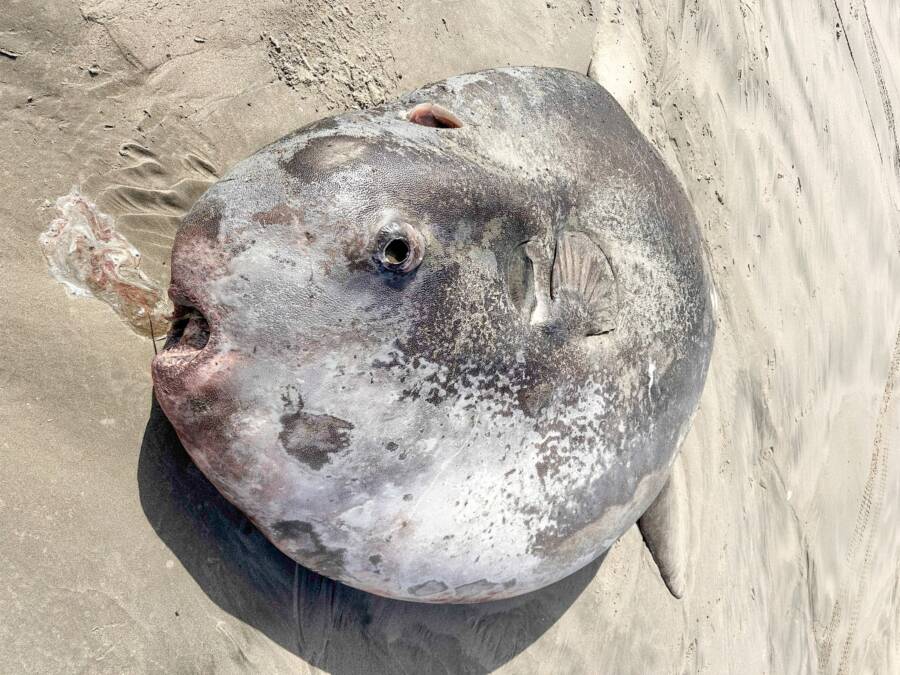The hoodwinker sunfish was first described by marine biologist Marianne Nyegaard in 2017, but the one that washed ashore in Oregon this month may be the largest ever observed.

Seaside Aquarium/FacebookThe 7.3-foot hoodwinker sunfish that washed ashore in Gearhart, Oregon.
Crowds of curious onlookers are flocking to Oregon’s northern coast to see a strange sight: a massive, 7.3-foot hoodwinker sunfish that washed up on Gearhart Beach on June 3.
But it wasn’t just the fish’s size that captured people’s attention. Hoodwinker sunfish were previously thought to only live in temperate waters in the southern hemisphere, making the fish’s sudden appearance in Oregon even more unusual.
The Seven-Foot Sunfish That Washed Ashore In Northern Oregon
Seaside Aquarium posted photographs of the large fish on Facebook, along with a post describing why, exactly, this fish washing ashore is so exciting for researchers.
As the aquarium explained, when photos of the fish first made the rounds on social media, they quickly attracted the attention of researcher Marianne Nyegaard, who had first described this exact species of sunfish — Mola tecta — in 2017.
At the time, the hoodwinker sunfish was dubbed “a new species hiding in plain sight,” only identified thanks to genetic sampling and further observation. Initially, the fish was believed only to live in the southern hemisphere, but sightings of the fish in California and even Alaska have since challenged that notion.

Seaside Aquarium/FacebookHoodwinker sunfish skin stays smooth as they age, unlike the ocean sunfish’s, which tends to wrinkle.
“Through photographs, Marianne confirmed that it was a hoodwinker and that this may be the largest specimen ever sampled,” the aquarium wrote.
At the time of writing, the aquarium noted that the fish would likely remain on Gearhart Beach for some time, possibly weeks, as the fish’s tough skin makes it difficult for scavengers to pierce.
“It is a remarkable fish,” they wrote, “and the aquarium encourages people to go see it for themselves.”
Coincidentally, Nyegaard, who lives in New Zealand, was visiting Seattle the same weekend the sunfish washed up. As fate would have it, she was able to go and see the fish in person and confirm it was indeed the very same species she identified seven years ago.
“As soon as we could, we just jumped in the car and drove down to see it,” Nyegaard told NBC News. “It was a fantastic coincidence. It doesn’t get any better than that. It’s like I can’t get away from them!”
How The Hoodwinker Sunfish Got Its Name
Back in 2017, Nyegaard, a marine biologist, realized there were some differences among the sunfish she was observing. Rather than having a tail like most fish, sunfish have a flap. The flap of the more common ocean sunfish — Mola mola — is wavy with bony formations. The Mola tecta‘s flap, however, is split into two parts that can move independently of one another.
“Why those two species need different backends, we don’t know,” Nyegaard said.
The name for sunfish, “mola,” comes from Latin, meaning “millstone” in reference to the fish’s flat, round body. “Tecta” in Latin means hidden or disguised, in this case referring to how the new hoodwinker species had been “hiding in plain sight.”

Seaside Aquarium/FacebookThe hoodwinker sunfish has thick skin that is difficult for scavengers to pierce.
The hoodwinker became the fifth species of sunfish known to scientists. But according to Nyegaard, these fish are still fairly mysterious.
One major question about them is whether the species can coexist in the same location — and if so, how. Likewise, it’s unclear if the hoodwinker sunfish near Australia and New Zealand are linked to the ones in the Pacific Northwest, perhaps by migrating across the equator.
For now, those questions remain unanswered, but anyone living near Gearhart, Oregon can likely still go and see this remarkably massive fish lying on the beach.
After reading about this massive fish that washed up, read about the time a whale washed up on a beach in Oregon — and was then blown up. Or, check out our list of the weirdest animals on planet Earth.





